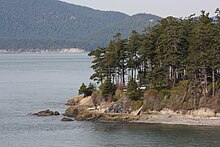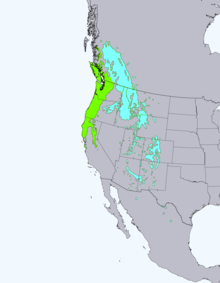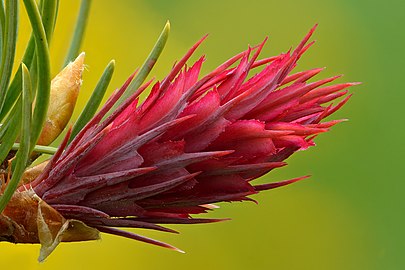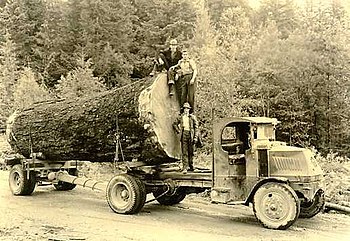| Douglas fir | |
|---|---|

| |

| |
| Conservation status | |
 Least Concern (IUCN 3.1) | |
 Secure (NatureServe) | |
| Scientific classification | |
| Kingdom: | Plantae |
| Clade: | Tracheophytes |
| Clade: | Gymnospermae |
| Division: | Pinophyta |
| Class: | Pinopsida |
| Order: | Pinales |
| Family: | Pinaceae |
| Genus: | Pseudotsuga |
| Species: | P. menziesii |
| Binomial name | |
| Pseudotsuga menziesii (Mirbel) Franco | |

| |
| Green: Coast Douglas-fir (Pseudotsuga menziesii var. menziesii) Blue: Rocky Mountain Douglas-fir (Pseudotsuga menziesii var. glauca) | |
| Synonyms | |
| |
The Douglas fir (Pseudotsuga menziesii) is an evergreen conifer species in the pine family, Pinaceae. It is native to western North America and is also known as Douglas-fir, Douglas spruce, Oregon pine, and Columbian pine. There are three varieties: coast Douglas-fir (P. menziesii var. menziesii), Rocky Mountain Douglas-fir (P. menziesii var. glauca) and Mexican Douglas-fir (P. menziesii var. lindleyana).
Despite its common names, it is not a true fir (genus Abies), spruce (genus Picea), or pine (genus Pinus). It is also not a hemlock; the genus name Pseudotsuga means "false hemlock".
Description
Douglas-firs are medium-size to extremely large evergreen trees, 20–100 metres (70–330 feet) tall (although only coast Douglas-firs, reach heights near 100 m) and commonly reach 2.4 m (8 ft) in diameter, although trees with diameters of almost 5 metres (16 feet) exist. The largest coast Douglas-firs regularly live over 500 years, with the oldest specimens living for over 1,300 years. Rocky Mountain Douglas-firs, found further to the east, are less long-lived, usually not exceeding 400 years in age.
There are records of former coast Douglas-firs exceeding 120 metres (390 feet) in height, which if alive today would make it the tallest tree species on Earth. Particular historical specimens with heights exceeding 400 feet include the Lynn Valley Tree and the Nooksack Giant.
The leaves are flat, soft, linear needles 2–4 centimetres (3⁄4–1+1⁄2 in) long, generally resembling those of the firs, occurring singly rather than in fascicles; they completely encircle the branches, which can be useful in recognizing the species. As the trees grow taller in denser forest, they lose their lower branches, such that the foliage may start as high as 34 m (110 ft) off the ground. Douglas-firs in environments with more light may have branches much closer to the ground.
The bark on young trees is thin, smooth, grey, and contains numerous resin blisters. On mature trees, usually exceeding 80 years, it is very thick and corky, growing up to 36 cm (14 in) thick with distinctive, deep vertical fissures caused by the gradual expansion of the growing tree. Some of the mature bark is brown, while other parts are lighter colored with a cork-like texture; these develop in multiple layers. This thick bark makes the Douglas-fir one of the most fire-resistant tree native to the Pacific Northwest.
The female cones are pendulous, with persistent scales, unlike those of true firs. They have distinctive long, trifid (three-pointed) bracts which protrude prominently above each scale and are said to resemble the back half of a mouse, with two feet and a tail.
The massive mega-genome of Douglas fir was sequenced in 2017 by the large PineRefSeq consortium, revealing a specialized photosynthetic apparatus in the light-harvesting complex of genes.
-
Mature individual in the Wenatchee Mountains
-
 Young female cone
Young female cone
-
 Mature female cone
Mature female cone
Taxonomy
The common name honors David Douglas, a Scottish botanist and collector who first reported the extraordinary nature and potential of the species. The common name is misleading since it is not a true fir, i.e., not a member of the genus Abies. For this reason, the name is often written as Douglas-fir (a name also used for the genus Pseudotsuga as a whole).
The specific epithet menziesii is after Archibald Menzies, a Scottish physician and rival naturalist to David Douglas. Menzies first documented the tree on Vancouver Island in 1791. Colloquially, the species is also known simply as Doug fir or Douglas pine (although the latter common name may also refer to Pinus douglasiana). Other names for this tree have included Oregon pine, British Columbian pine, Puget Sound pine, Douglas spruce, false hemlock, red fir, or red pine (although again red pine may refer to a different tree species, Pinus resinosa, and red fir may refer to Abies magnifica).
One Coast Salish name for the tree, used in the Halkomelem language, is lá:yelhp. In the Lushootseed language, the tree is called čəbidac.
Distribution
Pseudotsuga menziesii var. menziesii, the coast Douglas-fir, grows in the coastal regions from west-central British Columbia southward to central California. In Oregon and Washington, its range is continuous from the eastern edge of the Cascades west to the Pacific Coast Ranges and Pacific Ocean. In California, it is found in the Klamath and California Coast Ranges as far south as the Santa Lucia Range, with a small stand as far south as the Purisima Hills in Santa Barbara County. One of the last remaining old growth stands of conifers is in the Mattole Watershed, and is under threat of logging. In the Sierra Nevada, it ranges as far south as the Yosemite region. It occurs from sea level along the coast to elevations of 1,500 m (4,900 ft) or higher, and inland in some cases up to 2,100 m (6,900 ft).
Another variety exists further inland, Pseudotsuga menziesii var. glauca, the Rocky Mountain Douglas-fir or interior Douglas-fir. Interior Douglas-fir intergrades with coast Douglas-fir in the Cascades of northern Washington and southern British Columbia, and from there ranges northward to central British Columbia and southeastward to the Mexican border, becoming increasingly disjunct as latitude decreases and altitude increases. Mexican Douglas-fir (P. lindleyana), which ranges as far south as Oaxaca, is often considered a variety of P. menziesii.
Fossils (wood, pollen) of Pseudotsuga are recorded from the Miocene and Pliocene of Europe (Siebengebirge, Gleiwitz, Austria).
It is also naturalised throughout Europe, Argentina and Chile (called Pino Oregón). In New Zealand it is considered to be an invasive species, called a wilding conifer, and is subject to control measures. But is also one of the most common lumber trees used in forestry alongside Radiata pine with large plantations throughout the country. The species was introduced in the 1900s for its wood.
Ecology
Preferred sites
Douglas-fir prefers acidic or neutral soils. However, it exhibits considerable morphological plasticity, and on drier sites P. menziesii var. menziesii will generate deeper taproots. Pseudotsuga menziesii var. glauca exhibits even greater plasticity, occurring in stands of interior temperate rainforest in British Columbia, as well as at the edge of semi-arid sagebrush steppe throughout much of its range, where it generates even deeper taproots still.
The coast Douglas-fir variety is the dominant tree west of the Cascade Mountains in the Pacific Northwest. It occurs in nearly all forest types and competes well on most parent materials, aspects, and slopes. Adapted to a more moist, mild climate than the interior subspecies, it grows larger and faster than Rocky Mountain Douglas-fir. Associated trees include western hemlock, Sitka spruce, sugar pine, western white pine, ponderosa pine, grand fir, coast redwood, western redcedar, California incense-cedar, Lawson's cypress, tanoak, bigleaf maple and several others. Pure stands are also common, particularly north of the Umpqua River in Oregon. It is most dominant in areas with a more frequent fire regime that suppresses less fire-resistant conifers.
Use by animals

Douglas-fir seeds are an extremely important food source for small mammals such as moles, shrews, and chipmunks, which consume an estimated 65% of each annual seed crop. The Douglas squirrel harvests and hoards great quantities of Douglas-fir cones, and also consumes mature pollen cones, the inner bark, terminal shoots, and developing young needles.
Mature or "old-growth" Douglas-fir forest is the primary habitat of the red tree vole (Arborimus longicaudus) and the spotted owl (Strix occidentalis). Home range requirements for breeding pairs of spotted owls are at least 400 hectares (4.0 km; 990 acres) of old growth. Red tree voles may also be found in immature forests if Douglas-fir is a significant component. The red vole nests almost exclusively in the foliage of the trees, typically 2–50 metres (5–165 ft) above the ground, and its diet consists chiefly of Douglas-fir needles.
Douglas-fir needles are generally poor browse for ungulates, although in the winter when other food sources are lacking it can become important, and black-tailed deer browse new seedlings and saplings in spring and summer. The spring diet of the blue grouse features Douglas-fir needles prominently.
The leaves are also used by the woolly conifer aphid Adelges cooleyi; this 0.5 mm-long sap-sucking insect is conspicuous on the undersides of the leaves by the small white "fluff spots" of protective wax that it produces. It is often present in large numbers, and can cause the foliage to turn yellowish from the damage it causes. Exceptionally, trees may be partially defoliated by it, but the damage is rarely this severe. Among Lepidoptera, apart from some that feed on Pseudotsuga in general, the gelechiid moths Chionodes abella and C. periculella as well as the cone scale-eating tortrix moth Cydia illutana have been recorded specifically on P. menziesii.
The inner bark is the primary winter food for the North American porcupine.
Poriol is a flavanone, a type of flavonoid, produced by P. menziesii in reaction to infection by Poria weirii.
Value to other plants
A parasitic plant which uses P. menziesii is the Douglas-fir dwarf mistletoe (Arceuthobium douglasii). Epiphytes such as crustose lichens and mosses are common sights on Douglas-firs. As it is only moderately shade tolerant, undisturbed Douglas-fir stands in humid areas will eventually give way to later successional, more shade-tolerant associates such as the western redcedar and western hemlock—though this process may take a thousand years or more. It is more shade tolerant than some associated fire-dependent species, such as western larch and ponderosa pine, and often replaces these species further inland.
Diseases and insects
Fungal diseases such as laminated root rot and shoestring root-rot can cause significant damage, and in plantation settings dominated by Douglas-fir monocultures may cause extreme damage to vast swathes of trees. Interplanting with resistant or nonhost species such as western redcedar and beaked hazelnut can reduce this risk. Other threats to Douglas-fir include red ring rot and the Douglas-fir beetle.
Uses

Many different Native American groups used the bark, resin, and needles to make herbal treatments for various diseases. Native Hawaiians built waʻa kaulua (double-hulled canoes) from coast Douglas-fir logs that had drifted ashore. The wood has historically been favored as firewood, especially from the coastal variety. In addition early settlers used Douglas fir for all forms of building construction, including floors, beams, and fine carving.
The species is extensively used in forestry management as a plantation tree for softwood timber. Douglas-fir is one of the world's best timber-producing species and yields more timber than any other species in North America, making the forestlands of western Oregon, Washington, and British Columbia the most productive on the continent. In 2011, Douglas-fir represented 34.2% of US lumber exports, to a total of 1.053 billion board-feet. Douglas fir timber is used for timber frame construction and timber trusses using traditional joinery, veneer, and flooring due to its strength, hardness and durability. As of 2024, the only wooden ships still currently in use by the U.S. Navy in conventional naval operations are Avenger-class minesweepers, made of Douglas-fir.
Douglas fir sees wide use in heavy timber structures, as its wood is strong, available in a number of specifications including kiln dried and grade stamped, and can be supplied in very long lengths to 60 feet. West coast mills are sophisticated in their processing of timbers, making lead times predictable and availability reliable. Paints adhere well to Douglas fir. Stains perform well on Douglas fir timbers with the mild caution that the natural color of this species varies and care must be taken to ensure uniformity of color. Pitch pockets that may ooze resin can be present in timbers that have not been kiln dried. Because of the timber sizes available, stamped timber grading, and relatively short lead times, Douglas fir sees wide use in both public and residential projects.
The species has ornamental value in large parks and gardens. It has been commonly used as a Christmas tree since the 1920s, and the trees are typically grown on plantations.
The buds have been used to flavor eau de vie, a clear, colorless fruit brandy. Douglas-fir pine leaves can be used to make pine needle tea. They possess a tangy citrus flavor and may serve in some recipes as a wild substitute for rosemary.
See also
References
- Farjon, A. (2013). "Pseudotsuga menziesii". IUCN Red List of Threatened Species. 2013: e.T42429A2979531. doi:10.2305/IUCN.UK.2013-1.RLTS.T42429A2979531.en. Retrieved 19 November 2021.
- NatureServe (6 December 2024). "Pseudotsuga menziesii". NatureServe Explorer. Arlington, Virginia. Retrieved 8 December 2024.
- "Taxonomy - GRIN-Global Web v 1.10.5.0". npgsweb.ars-grin.gov. Retrieved 24 September 2019.
- "Pseudotsuga menziesii ". Calflora. Berkeley, California: The Calflora Database.
- Lipscomb, Barney (1993). "Pseudotsuga menziesii". In Flora of North America Editorial Committee (ed.). Flora of North America North of Mexico (FNA). Vol. 2. New York and Oxford: Oxford University Press. Retrieved 2018-11-07 – via eFloras.org, Missouri Botanical Garden, St. Louis, MO & Harvard University Herbaria, Cambridge, MA.
- "Douglas Fir".
- ^ "Pseudotsuga menziesii var. menziesii ". Calflora. Berkeley, California: The Calflora Database.
- ^ Wilson, Donald A. (2008-01-28). Forensic procedures for boundary and title investigation. John Wiley & Sons. ISBN 9780470113691.
- NRCS. "Pseudotsuga menziesii". PLANTS Database. United States Department of Agriculture (USDA). Retrieved 2018-11-07.
- Carder, Al (1995). Forest Giants of the World Past and Present. pp. 3–4.
- Brockman, C. Frank (1968). "Pseudotsuga menziesii". Trees of North America: A Guide to Field Identification. New York: Golden Press. pp. 44–45. ISBN 0-307-13658-2.
- "World's Largest Douglas-fir Tree - the Red Creek Fir!". 8 June 2011.
- ^ Van Pelt, Robert (2007). "Identifying Mature and Old Forests In Western Washington" (PDF) (pdf). Washington State Department of Natural Resources. Archived (PDF) from the original on 11 November 2020. Retrieved 1 September 2021.
- ^ Arno, Stephen F.; Hammerly, Ramona P. (2020) . Northwest Trees: Identifying & Understanding the Region's Native Trees (field guide ed.). Seattle: Mountaineers Books. pp. 101–110. ISBN 978-1-68051-329-5. OCLC 1141235469.
- "Douglas Fir: Pseudotsuga menziesii". National Wildlife Federation. Retrieved 1 September 2021.
- "Tallest Douglas Fir in America". 12 November 2012.
- "Giant logged long ago but not forgotten". 4 September 2011.
- Russell, Tony; Cutler, Catherine; Walters, Martin (2014). "Pseudotsuga menziesii". The Illustrated Encyclopedia of Trees of the World. London: Anness Publishing Ltd. p. 120. ISBN 978-1-4351-5597-8.
- ^ "Pseudotsuga menziesii var. menziesii". www.fs.fed.us. Retrieved 2021-05-11.
- Van Pelt, Robert (2007). "Identifying Mature and Old Forests In Western Washington" (PDF) (pdf). Washington State Department of Natural Resources. Archived (PDF) from the original on 11 November 2020. Retrieved 11 May 2021.
- "U.S. Fish and Wildlife Service, Open Spaces Blog". www.fws.gov. Retrieved 2021-05-12.
- Neale DB (2017). "The Douglas-Fir Genome Sequence Reveals Specialization of the Photosynthetic Apparatus in Pinaceae". G3: Genes, Genomes, Genetics. 7 (9): 3157–3167. doi:10.1534/g3.117.300078. PMC 5592940. PMID 28751502.
- "Douglas-fir (Pseudotsuga)". Common Trees of the Pacific Northwest. Oregon State University. Archived from the original on 2012-12-19. Retrieved 2022-02-13.
- Farjon, A. (2013). "Pinus douglasiana". IUCN Red List of Threatened Species. 2013: e.T42357A2974933. doi:10.2305/IUCN.UK.2013-1.RLTS.T42357A2974933.en. Retrieved 19 November 2021.
- NRCS. "Pinus resinosa". PLANTS Database. United States Department of Agriculture (USDA). Retrieved 2018-11-07.
- Galloway, Brent Douglas. Dictionary of Upriver Halkomelem. Vol. I. p. 213.
- "čəbidac". Lushootseed: the language of Puget Sound. March 18, 2017.
- Griffin, James R. (September 1964). "A New Douglas-Fir Locality in Southern California". Forest Science: 317–319. Retrieved December 31, 2010.
- Griffin, James R.; Critchfield, William B. (1976). The Distribution of Forest Trees in California USDA Forest Service Research Paper PSW – 82/1972 (PDF). Berkeley, California: USDA Forest Service. p. 114. Retrieved 2015-05-03.
- "Douglas Fir, Then and Now | The Seattle Times". archive.seattletimes.com.
- "Tensions Rise In the Battle To Save Old Trees". Cal Alumni Association. September 1, 2018.
- R. K. Hermann (October 1985). The Genus Pseudotsuga : Ancestral History and Past Distribution (Special Publication 2b). Forest Research Laboratory, College of Forestry, Oregon State University. pp. 23–24.
- "Distribution of Douglas-fir". Royal Botanical Garden Edinburgh. Archived from the original on 2012-02-15. Retrieved 2009-01-31.
- "Weed Information Sheet". Weedbusters. Retrieved 2021-05-12.
- "Douglas-fir". www.nzfoa.org.nz.
- "Douglas-fir Tree on the Tree Guide". arborday.org.
- Barton GM (1972). "New C-methylflavanones from Douglas-fir". Phytochemistry. 11 (1): 426–429. Bibcode:1972PChem..11..426B. doi:10.1016/S0031-9422(00)90036-0.
- "Corylus cornuta". www.fs.fed.us. Retrieved 2021-05-12.
- "Douglas Fir" (PDF). Retrieved 2020-02-21.
- "Pseudotsuga menziesii var. menziesii ". The Gymnosperm Database. Retrieved March 17, 2013.
This was the preferred species for Hawaiian war canoes. The Hawaiians, of course, did not log the trees; they had to rely on driftwood.
- Curtis, Robert; Carey, Andrew (1996). Timber Supply in the Pacific Northwest (PDF). USDA Forest Service.
- "Douglas-Fir". Wood Database. Retrieved August 15, 2018.
- Tarantola, Andrew (23 May 2012). "The Navy's Wooden Avengers Are Real-Life Mine Sweepers". Gizmodo.
wooden hulls—typically oak, Douglas-fir, or Nootka Cypress—coated in glass-reinforced plastic
- "Pseudotsuga menziesii ". Royal Horticultural Society. Archived from the original on 2013-11-09. Retrieved 2012-07-14.
- "Douglas-Fir". National Christmas Tree Association. Archived from the original on 2020-08-03. Retrieved 2022-02-10.
- Asimov, Eric (August 15, 2007). "An Orchard in a Bottle, at 80 Proof". The New York Times. Retrieved February 1, 2009.
- "Foraging for Pine Needles (and other conifer needles)". Grow Forage Cook Ferment. December 23, 2015.
- Boyd, Sabra (November 27, 2020). "As a homeless teen, I foraged for wild food to survive. The lessons still shape my cooking". The Washington Post. Archived from the original on November 27, 2020. Retrieved December 1, 2020.
Further reading
- Brock, Emily K. (2015). Money Trees: The Douglas-Fi.r and American Forestry, 1900–1944 Corvallis, Oregon: Oregon State University Press.
- Chase, J. Smeaton (1911). "Pseudotsuga taxifolia, Also called P. douglasii or P. mucronata, (Douglas-spruce, Douglas-pine, Hemlock, Red-fir)". Cone-bearing Trees of the California Mountains. Eytel, Carl (illustrations). Chicago: A.C. McClurg & Co. p. 36. LCCN 11004975. OCLC 3477527.
- Uchytil, Ronald J. (1991). "Pseudotsuga menziesii var. menziesii". Fire Effects Information System (FEIS). US Department of Agriculture (USDA), Forest Service (USFS), Rocky Mountain Research Station, Fire Sciences Laboratory.
External links
- Conifers.org: Pseudotsuga menziesii
- Arboretum de Villardebelle – cone photos
- Humboldt State University — Photo Tour: Douglas-fir, Pseudotsuga menziesii — Institute for Redwood Ecology.
- Pseudotsuga menziesii - information, genetic conservation units and related resources. European Forest Genetic Resources Programme (EUFORGEN).
| Taxon identifiers | |
|---|---|
| Pseudotsuga menziesii |
|
| Abies menziesii | |
- IUCN Red List least concern species
- NatureServe secure species
- Pseudotsuga
- Pacific temperate rainforests
- Flora of Central Mexico
- Flora of Northeastern Mexico
- Flora of Northwestern Mexico
- Flora of Southwestern Mexico
- Flora of the Northwestern United States
- Flora of the Southwestern United States
- Flora of the South-Central United States
- Flora of Alaska
- Flora of Alberta
- Flora of British Columbia
- Trees of Northern America